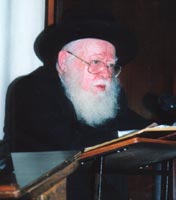Avraham Shapira
Rabbi Avraham Shapira אברהם שפירא | |
|---|---|
 | |
| Title | Ashkenazi Chief Rabbi of Israel |
| Personal | |
| Religion | Judaism |
| Nationality | Israeli |
| Denomination | Orthodox |
| Began | 1983 |
| Ended | 1993 |
Avraham Shapira (Template:Lang-he; 20 May 1914, Jerusalem[1] – 27 September 2007) was a prominent rabbi in the Religious Zionist world. Shapira had been the head of the Rabbinical court of Jerusalem, and both a member and the head of the Supreme Rabbinic Court. He served as the Ashkenazi Chief Rabbi of Israel from 1983 to 1993. Shapira was the rosh yeshiva of Mercaz haRav in Jerusalem, a position he held since Rabbi Zvi Yehuda Kook died in 1982.
Biography
Avraham Elkanah Shapira was born to a Jerusalemite family; his father was Rabbi Shlomo Zalman Shapira. As a child, he studied at Etz Chaim Yeshiva in Jerusalem, later moving to the Hebron Yeshiva, where he studied under Rabbis Moshe Mordechai Epstein and Yechezkel Sarna. After his marriage, he was invited to join Mercaz HaRav yeshiva,
Rabbi Shapira corresponded in his youth with the Chazon Ish, Rabbi Zvi Pesach Frank, Rabbi Yitzchak Zev Soloveitchik, and Rabbi Isser Zalman Meltzer.
In 1956, he was appointed as a member of the Jerusalem religious court by the chief rabbi Yitzhak HaLevi Herzog. In 1971, he was appointed Av Beit Din, and in 1983, he became ashkenazi chief rabbi of Israel, serving alongside Rabbi Mordechai Eliyahu, who was elected sefardi chief rabbi.
Rabbi Shapira died on the first day of Succot of 2007.[2][3] Fifteen days earlier, on the preceding Rosh Hashana, he had been brought to prayers in a wheelchair. Within days, he was hospitalized, and did not recover.
Tens of thousands of people took part in his funeral procession on September 28, 2007. Occurring on the eve of Shabbat,[4] the procession stretched from its starting point at the Mercaz HaRav Yeshiva, through the streets of Jerusalem, past the original location of the yeshiva in the Geula neighbourhood, and terminated at the Mount of Olives cemetery, where Rabbi Shapira was interred.
Published works
- Shiurey Maran HaGra Shapira - A summary of the Rabbi's lectures, comprising six volumes.
- Minchat Avraham - A collection of original halachic essays, comprising three volumes.
- Morasha - Original essays on various topics.
References
- ^ Selah, Kobi. הגאון הרב אברהם שפירא הלך לעולמו (in Hebrew). Arutz 7. Archived from the original on 21 October 2007. Retrieved 2007-10-01.
נולד בירושלים בכד אייר תרע"ד
{{cite web}}: Cite has empty unknown parameters:|month=and|coauthors=(help); Unknown parameter|deadurl=ignored (|url-status=suggested) (help) - ^ Wagner, Mattew (2007-09-28). "Rabbi Avraham Shapira dies at 94". Jerusalem Post. Retrieved 2007-09-28.
{{cite news}}: Cite has empty unknown parameter:|coauthors=(help)[dead link] - ^ Shragai, Nadav (2007-09-28). "Former chief Ashkenazi rabbi Abraham Shapira dies at 96". Haaretz. Archived from the original on 11 October 2007. Retrieved 2007-09-28.
{{cite news}}: Cite has empty unknown parameter:|coauthors=(help); Unknown parameter|deadurl=ignored (|url-status=suggested) (help) - ^ Copans, Laurie (2007-09-28). "Former Chief Rabbi of Israel Dies". Chicago Tribune. Retrieved 2007-09-29.
